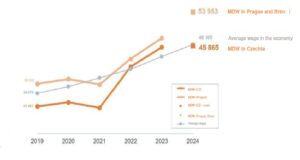How does it differ from the average or minimum wage?
The way a minimum decent wage is calculated differs from how other commonly used instruments for describing and determining wage levels are determined:
An average and median wage are statistical instruments which serve to describe the actual distribution of real wages across society. They tell us about actual wages, although nothing about things from the perspective of expenses, nor the standard of life one is able to attain with such a wage.
A minimum wage serves as a way to politically influence the labor market. Its amount is the result of political negotiations between unions, employees, and the state. Thus, this instrument is also unable to tell us what one can or cannot afford with such a wage.
A minimum decent wage, on the other hand, attempts to determine in numbers how much a worker needs to earn in order to be able to cover expenses which will afford them a basic material standard. It is based on the assumption that a person working a full-time job should be able to live a decent life. In this way, we bring to the debate the perspective of employees and their living conditions, which, up until this point, has been sorely missing.
How does it differ from instruments that measure poverty?
A minimum decent wage also differs from instruments that measure poverty, as they aim to capture the situation of households that have a difficulty covering their basic needs (i.e., material deprivation) or that have a significantly lower wage than the majority of society (i.e., threatened by wage poverty); alternatively, such instruments aim to determine in numbers the minimum financial amount needed for survival (i.e., the Czech social policy instrument of a so-called living minimum).
In between the two states of sheer poverty and ensuring a modest material-level of decency lies the still rarely discussed issue of economic uncertainty. This is something that people even employed full-time can experience – they, in fact, can cover the expenses necessary for immediate survival, although many have a problem covering other everyday expenses.
The minimum decent wage instrument, therefore, highlights these people’s situation and their need for a higher wage, which thus would allow them to break free from economic uncertainty.
How HAS IT DEVELOPED in time?

How is the concept of a decent wage approached abroad?
The definition of a Czech minimum decent wage and the way that it has been calculated has been influenced by similar concepts from abroad, most notably by the concept of a living wage. In developing countries, the term floor wage is used, which, nevertheless, refers to the poverty level rather than to a decent wage.
Chosen sources:
- Concept and practice of a living wage (Eurofound, 2018) – basic overview of the background and history of the concept, national initiatives, impact assessments.
- From minimum to living wages – lessons from different European practices (2019) – a special edition of the magazine Transfer devoted to European experiences with a living wage.
- Living wage a relevant topic for Europe (European Trade Union Institute, 2018) – a policy paper on the potential role of a living wage in the European Union.
- Living Wages Around the World – Manual for Measurement (Edward Elgar Publishing, 2017) – a methodological manual drawing on 10 years of experience with living wage calculations from around the world.
- Estimating a living wage: A methodological review
(International Labour Organisation, 2011) -– published by the International Labour Organisation, it is one of the first methodologies created for calculating a living wage.
Initiatives abroad:
- Living wage foundation – thus far, the most developed of the British initiatives for calculating a living wage; includes employer certification as well. The amount has been calculated for Scotland.
- Living Wage Calculator (Massachusetts Institute of Technology) – an expert calculator for various regions of the United States and according to various household statuses.
- Living Wage Ireland – Irish initiative.
- Living Wage New Zeland – New Zealand initiative.
- Living Wage Canada – Canadian initiative that coordinates regional activity.
- Asia Floor Wage – the minimum amount needed to cover basic needs – this initiative focuses on the problem of extremely low wages of global Asian companies (e.g., textile industry).